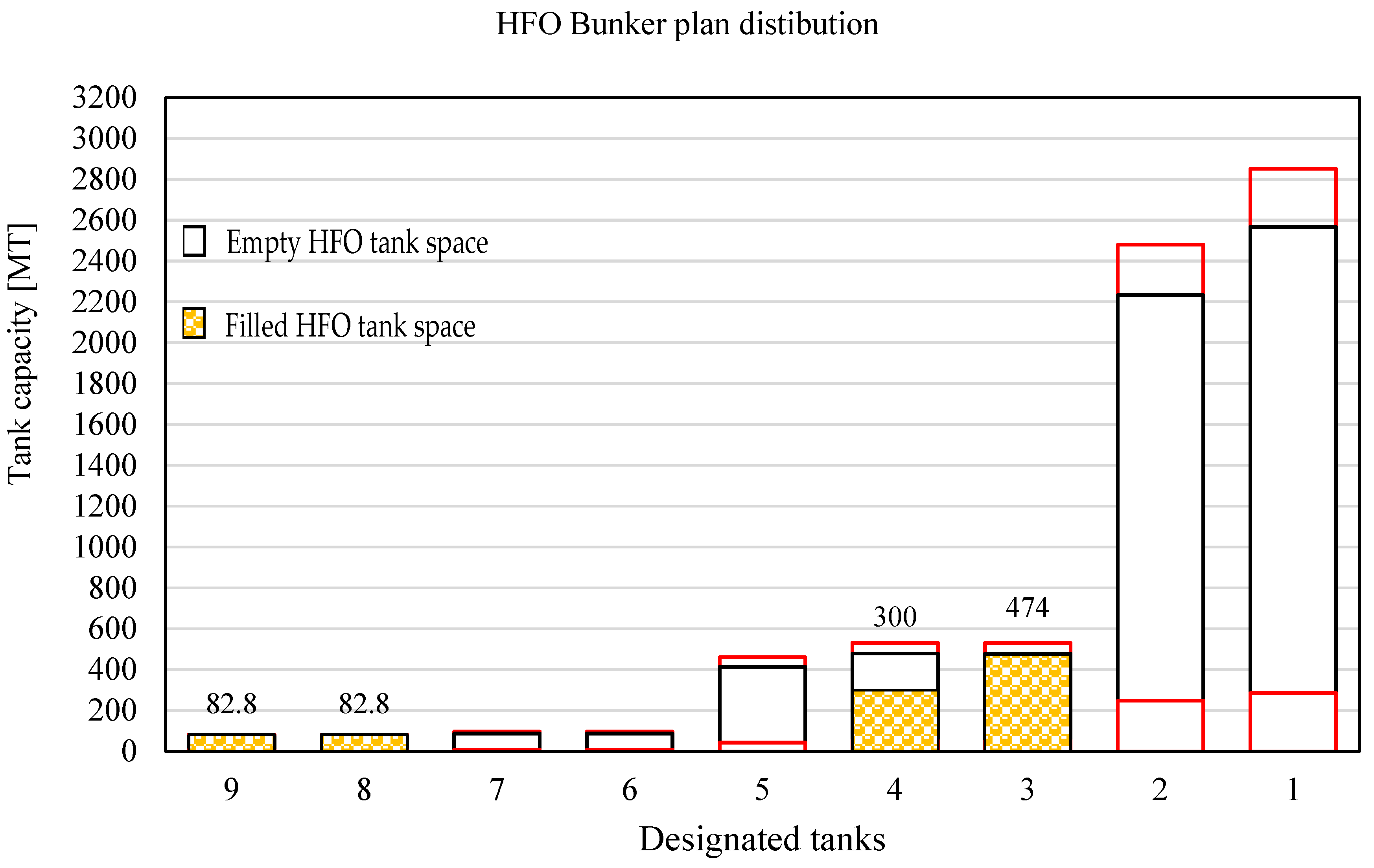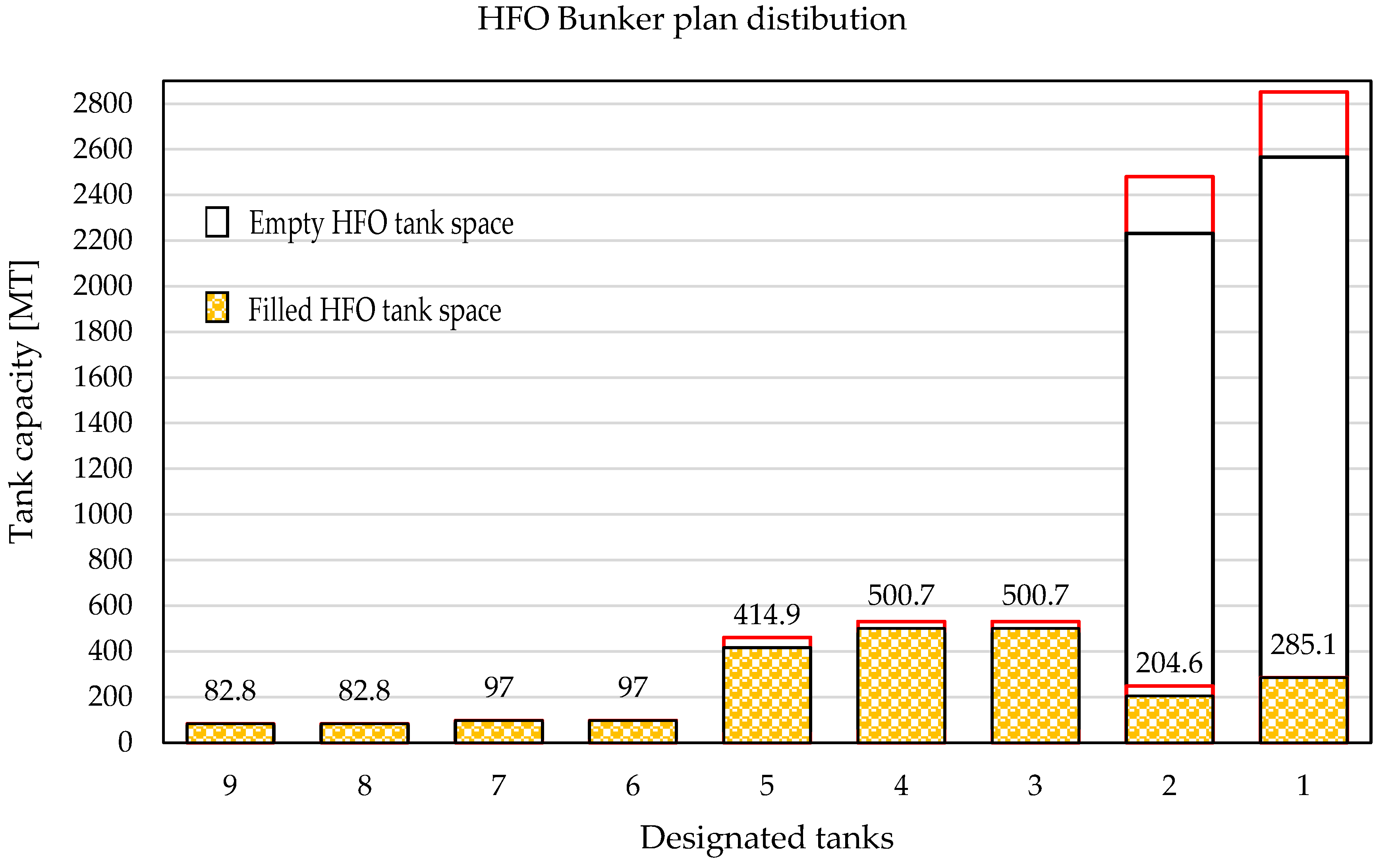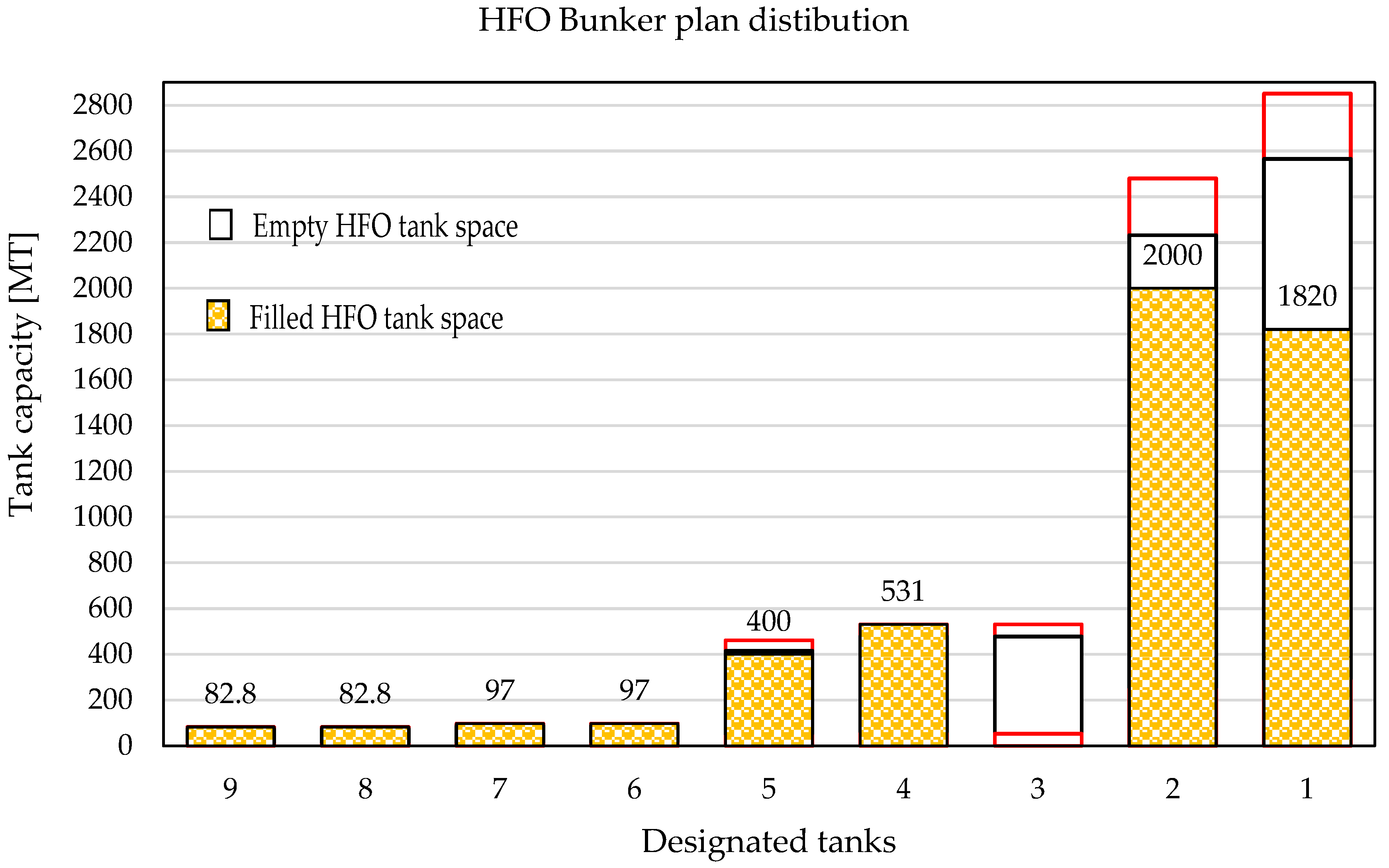Bisection Method for the Heavy Fuel Oil Tank Filling Problem at a Liquefied Natural Gas Carrier
Abstract
1. Introduction
2. Description of the Heavy Fuel Oil Tanks and Their Application
3. Mathematical Model of HFO Bunker Distribution and Maximal Loading Quantities inside the HFO Tanks
3.1. Mathematical Explanation of the Given Problem
3.2. Mathematical Binary Setup and Filling Limits
3.3. Examples of the Fuel Distribution by Using the Bisection Method
3.4. Mathematical Spectrum of Solution Intervals
4. Conclusions
Author Contributions
Funding
Data Availability Statement
Conflicts of Interest
Abbreviations
| DM | Distillate Marine Fuel Oil |
| HFO | Heavy Fuel Oil |
| HSFO | High-Sulphur Fuel Oil |
| IMO | International Maritime Organisation |
| LNG | Liquefied Natural Gas |
| LSHFO | Low-Sulphur Fuel Oil |
| MARPOL | International Convention for the Prevention of Pollution from Ships |
| RM | Residual Marine Fuel Oil |
| SECAs | Sulphur Emission Control Area |
| VLSFO | Very-Low-Sulphur Fuel Oil |
References
- Fowler, D.; Brimblecombe, P.; Burrows, J.; Heal, M.R.; Grennfelt, P.; Stevenson, D.S.; Jowett, A.; Nemitz, E.; Coyle, M.; Liu, X.; et al. A Chronology of Global Air Quality. Phil. Trans. R. Soc. A 2020, 378, 20190314. [Google Scholar] [CrossRef] [PubMed]
- Notes of Heavy Fuel Oil by the American Bureau of Shipping, ABS Plaza, 16855 Northchase Drive, Houston, TX 77060 USA. 2001. Available online: https://cupdf.com/document/notes-on-heavy-fuel-oil-1984.html (accessed on 27 March 2023).
- Thomas, J.; Sluder, S.; Kass, M.; Theiss, T. A Guide to Fuel, Lubricant, and Engine Concerns Relative to the IMO 2020 Fuel Oil Sulfur Reduction Mandate; Oak Ridge National Laboratory: Oak Ridge, TN, USA, 2019. [CrossRef]
- Jonidi Jafari, A.; Charkhloo, E.; Pasalari, H. Urban Air Pollution Control Policies and Strategies: A Systematic Review. J. Environ. Health Sci. Eng. 2021, 19, 1911–1940. [Google Scholar] [CrossRef] [PubMed]
- Yue, Y.; Ying, Y. Real option analysis for emission reduction investment under the sulfur emission control. Sustain. Energy Technol. Assess. 2021, 45, 101055. [Google Scholar] [CrossRef]
- Manisalidis, I.; Stavropoulou, E.; Stavropoulos, A.; Bezirtzoglou, E. Environmental and Health Impacts of Air Pollution: A Review. Front. Public Health 2020, 8, 14. [Google Scholar] [CrossRef] [PubMed]
- Kass, M.; Kaul, B.; Armstrong, B.; Szybist, J.; Lobodin, V. Stability, rheological and combustion properties of biodiesel blends with a very-low sulfur fuel oil (VLSFO). Fuel 2022, 316, 123365. [Google Scholar] [CrossRef]
- Tariq, A.I.; Saleh, A.M. An experimental investigation into the combustion properties, performance, emissions, and cost reduction of using heavy and light fuel oils. Case Stud. Therm. Eng. 2023, 44, 102832. [Google Scholar] [CrossRef]
- Poljak, I. Marine Power Systems. J. Mar. Sci. Eng. 2022, 10, 195. [Google Scholar] [CrossRef]
- Merico, E.; Cesari, D.; Gregoris, E.; Gambaro, A.; Cordella, M.; Contini, D. Shipping and Air Quality in Italian Port Cities: State-of-the-Art Analysis of Available Results of Estimated Impacts. Atmosphere 2021, 12, 536. [Google Scholar] [CrossRef]
- Papadopoulos, C.; Kourtelesis, M.; Moschovi, A.M.; Sakkas, K.M.; Yakoumis, I. Selected Techniques for Cutting SOx Emissions in Maritime Industry. Technologies 2022, 10, 99. [Google Scholar] [CrossRef]
- Shi, J.; Zhu, Y.; Feng, Y.; Yang, J.; Xia, C. A Prompt Decarbonization Pathway for Shipping: Green Hydrogen, Ammonia, and Methanol Production and Utilization in Marine Engines. Atmosphere 2023, 14, 584. [Google Scholar] [CrossRef]
- Wang, Y.; Cao, Q.; Liu, L.; Wu, Y.; Liu, H.; Gu, Z.; Zhu, C. A Review of Low and Zero Carbon Fuel Technologies: Achieving Ship Carbon Reduction Targets. Sustain. Energy Technol. Assess. 2022, 54, 102762. [Google Scholar] [CrossRef]
- Zhang, Y.; Xia, C.; Liu, D.; Zhu, Y.; Feng, Y. Experimental Investigation of the High-Pressure SCR Reactor Impact on a Marine Two-Stroke Diesel Engine. Fuel 2023, 335, 127064. [Google Scholar] [CrossRef]
- Smyshlyaeva, K.I.; Rudko, V.A.; Povarov, V.G.; Shaidulina, A.A.; Efimov, I.; Gabdulkhakov, R.R.; Pyagay, I.N.; Speight, J.G. Influence of Asphaltenes on the Low-Sulphur Residual Marine Fuels’ Stability. J. Mar. Sci. Eng. 2021, 9, 1235. [Google Scholar] [CrossRef]
- Aakko-Saksa, P.T.; Lehtoranta, K.; Kuittinen, N.; Järvinen, A.; Jalkanen, J.-P.; Johnson, K.; Jung, H.; Ntziachristos, L.; Gagné, S.; Takahashi, C.; et al. Reduction in Greenhouse Gas and Other Emissions from Ship Engines: Current Trends and Future Options. Prog. Energy Combust. Sci. 2023, 94, 101055. [Google Scholar] [CrossRef]
- Sultanbekov, R.; Islamov, S.; Mardashov, D.; Beloglazov, I.; Hemmingsen, T. Research of the Influence of Marine Residual Fuel Composition on Sedimentation Due to Incompatibility. J. Mar. Sci. Eng. 2021, 9, 1067. [Google Scholar] [CrossRef]
- Article: IMO 2020 and beyond: Review of Marine Fuels Quality. Available online: https://www.standard-club.com/knowledge-news/article-imo-2020-and-beyond-review-of-marine-fuels-quality-1674/ (accessed on 16 February 2023).
- Sultanbekov, R.; Beloglazov, I.; Islamov, S.; Ong, M.C. Exploring of the Incompatibility of Marine Residual Fuel: A Case Study Using Machine Learning Methods. Energies 2021, 14, 8422. [Google Scholar] [CrossRef]
- Opis A Dow Jones Company. Available online: https://www.opisnet.com/glossary-term/commingling/#:~:text=Term%20which%20generally%20applies%20to,the%20integrity%20of%20the%20brand (accessed on 9 March 2023).
- Ford, C.M. A Master’s Guide to: Using Fuel Oils Onboard Ships, The Standard ABS, Charles Taylor and Co. Limited, February 2012. Available online: https://dokumen.tips/documents/a-masters-guide-to-using-fuel-oil-onboard-ships.html?page=6 (accessed on 27 March 2023).
- Marine Trafic. Available online: https://www.marinetraffic.com/en/ais/details/ships/shipid:712370/mmsi:538003020/imo:9360867/vessel:AL_UTOURIYA (accessed on 9 March 2023).
- What Is Bunker (Ship), About Bunker Fuel and Bunkering Procedure. Available online: https://livebunkers.com/what-bunker-ship-about-bunker-fuel-and-bunkering-procedure (accessed on 9 March 2023).
- Arfken, G. Mathematical Methods for Physicists, 3rd ed.; Academic Press: Orlando, FL, USA, 1985; pp. 964–965. [Google Scholar]
- Press, W.H.; Flannery, B.P.; Teukolsky, S.A.; Vetterling, W.T. Bracketing and Bisection. In Numerical Recipes in FORTRAN: The Art of Scientific Computing, 2nd ed.; Cambridge University Press: Cambridge, UK, 1992; pp. 343–347. [Google Scholar]
- Anđelić, N.; Baressi Šegota, S.; Lorencin, I.; Poljak, I.; Mrzljak, V.; Car, Z. Use of Genetic Programming for the Estimation of CODLAG Propulsion System Parameters. J. Mar. Sci. Eng. 2021, 9, 612. [Google Scholar] [CrossRef]
- Strušnik, D.; Avsec, J. Artificial neural networking and fuzzy logic exergy controlling model of combined heat and power system in thermal power plant. Energy 2015, 80, 318–330. [Google Scholar] [CrossRef]








| HFO Tank | 100% [m3] | 90% [m3] | 85% [m3] |
|---|---|---|---|
| HFO Tank Forward (Port) | 3457.6 | 3111.8 | 2938.9 |
| HFO Tank Forward (Starboard) | 3007.4 | 2706.7 | 2556.3 |
| HFO Tank Aft (Port) | 608.2 | 547.4 | - |
| HFO Tank Aft (Starboard) | 608.2 | 547.4 | - |
| HFO Settling Tank (Port) | 111.1 | 100 | - |
| HFO Settling Tank (Starboard) | 111.1 | 100 | - |
| HFO Service Tank (Port) | 94.8 | 85.3 | - |
| HFO Service Tank (Starboard) | 94.8 | 85.3 | - |
| LSHFO tank (Starboard) | 528.1 | 475.3 | - |
| HFO Tank | 100% [MT] | 90% [MT] | 85% [MT] |
|---|---|---|---|
| HFO Tank Forward (Port), (No1) | 3353.9 | 3018.4 | 2850.8 |
| HFO Tank Forward (Starboard), (No2) | 2917.2 | 2625.5 | 2479.6 |
| HFO Tank Aft (Port), (No3) | 590 | 531 | - |
| HFO Tank Aft (Starboard), (No4) | 590 | 531 | - |
| HFO Settling Tank (Port), (No6) | 100 | 97 | - |
| HFO Settling Tank (Starboard), (No7) | 100 | 97 | - |
| HFO Service Tank (Port), (No8) | 85.4 | 82.8 | - |
| HFO Service Tank (Starboard), (No9) | 85.4 | 82.8 | - |
| LSHFO tank (Starboard), (No5) | 475.3 | 461 | - |
| Permutation | No1 | No2 | No3 | No4 | No5 | No6 | No7 |
|---|---|---|---|---|---|---|---|
| 0 | 0 | 0 | 0 | 0 | 0 | 0 | 0 |
| 1 | 0 | 0 | 0 | 0 | 0 | 0 | 1 |
| 2 | 0 | 0 | 0 | 0 | 0 | 1 | 0 |
| 3 | 0 | 0 | 0 | 0 | 0 | 1 | 1 |
| 4 | 0 | 0 | 0 | 0 | 1 | 0 | 0 |
| 5 | 0 | 0 | 0 | 0 | 1 | 0 | 1 |
| 6 | 0 | 0 | 0 | 0 | 1 | 1 | 0 |
| 7 | 0 | 0 | 0 | 0 | 1 | 1 | 1 |
| 8 | 0 | 0 | 0 | 1 | 0 | 0 | 0 |
| 9 | 0 | 0 | 0 | 1 | 0 | 0 | 1 |
| 10 | 0 | 0 | 0 | 1 | 0 | 1 | 0 |
| 11 | 0 | 0 | 0 | 1 | 0 | 1 | 1 |
| 12 | 0 | 0 | 0 | 1 | 1 | 0 | 0 |
| 13 | 0 | 0 | 0 | 1 | 1 | 0 | 1 |
| 14 | 0 | 0 | 0 | 1 | 1 | 1 | 0 |
| 15 | 0 | 0 | 0 | 1 | 1 | 1 | 1 |
| 16 | 0 | 0 | 1 | 0 | 0 | 0 | 0 |
| 17 | 0 | 0 | 1 | 0 | 0 | 0 | 1 |
| 18 | 0 | 0 | 1 | 0 | 0 | 1 | 0 |
| 19 | 0 | 0 | 1 | 0 | 0 | 1 | 1 |
| 20 | 0 | 0 | 1 | 0 | 1 | 0 | 0 |
| 21 | 0 | 0 | 1 | 0 | 1 | 0 | 1 |
| 22 | 0 | 0 | 1 | 0 | 1 | 1 | 0 |
| 23 | 0 | 0 | 1 | 0 | 1 | 1 | 1 |
| 24 | 0 | 0 | 1 | 1 | 0 | 0 | 0 |
| … | … | … | … | … | … | … | … |
| 36 | 0 | 1 | 0 | 0 | 0 | 1 | 1 |
| … | … | … | … | … | … | … | … |
| 128 | 1 | 1 | 1 | 1 | 1 | 1 | 1 |
| Tank No | 0% | 10% [MT] | 90% [MT] | 100% [MT] |
|---|---|---|---|---|
| No1 | 0 | 285.1 | 2565.7 | 2850.8 |
| No2 | 0 | 248 | 2231.6 | 2479.6 |
| No3 | 0 | 53.1 | 477.9 | 531 |
| No4 | 0 | 53.1 | 477.9 | 531 |
| No5 | 0 | 46.1 | 414.9 | 461 |
| No6 | 0 | 9.7 | 87.3 | 97 |
| No7 | 0 | 9.7 | 87.3 | 97 |
| Tank No | 0% | 10% | 90% | 100% | Fixed–Varied Tanks |
|---|---|---|---|---|---|
| No1 | 0 | 285.1 | 3776.8 | 4196.5 | 1-2, 3, 4, 5, 6, 7 |
| No2 | 0 | 248 | 4110.9 | 4567.7 | 2-1, 3, 4, 5, 6, 7 |
| No3 | 0 | 53.1 | 5864.7 | 6514.4 | 3-1, 2, 4, 5, 6, 7 |
| No4 | 0 | 53.1 | 5864.7 | 6516.4 | 4-1, 2, 3, 5, 6, 7 |
| No5 | 0 | 46.1 | 5927.7 | 6586.3 | 5-1, 2, 3, 4, 6, 7 |
| No6 | 0 | 9.7 | 6255.3 | 6950.3 | 6-1, 2, 3, 4, 5, 7 |
| No7 | 0 | 9.7 | 6255.3 | 6950.3 | 7-1, 2, 3, 4, 5, 6 |
| Tank No | 0% | 10% | 90% | 100% | Fixed–varied tanks |
| No1 | 0 | 285.1 | 3689.6 | 4099.4 | 1-2, 3, 4, 5, 6 |
| No2 | 0 | 248 | 4023.6 | 4470.7 | 2-1, 3, 4, 5, 6 |
| No3 | 0 | 53.1 | 5777.4 | 6419.4 | 3-1, 2, 4, 5, 6 |
| No4 | 0 | 53.1 | 5777.4 | 6419.4 | 4-1, 2, 3, 5, 6 |
| No5 | 0 | 46.1 | 5840.4 | 6489.3 | 5-1, 2, 3, 4, 6 |
| No6 | 0 | 9.7 | 6255.3 | 6950.3 | 6-1, 2, 3, 4, 5 |
| Tank No | 0% | 10% | 90% | 100% | Fixed–varied tanks |
| No1 | 0 | 285.1 | 3602.3 | 4002.5 | 1-2, 3, 4, 5 |
| No2 | 0 | 248 | 3936.3 | 4373.7 | 2-1, 3, 4, 5 |
| No3 | 0 | 53.1 | 5690.1 | 6322.4 | 3-1, 2, 4, 5 |
| No4 | 0 | 53.1 | 5690.1 | 6322.4 | 4-1, 2, 3, 5 |
| No5 | 0 | 46.1 | 5753 | 6853.3 | 5-1, 2, 3, 4 |
| Tank No | 0% | 10% | 90% | 100% | Fixed–varied tanks |
| No1 | 0 | 285.1 | 3187.4 | 3541.5 | 1-2, 3, 4 |
| No2 | 0 | 248 | 3521.4 | 3912.7 | 2-1, 3, 4 |
| No3 | 0 | 53.1 | 5275.2 | 5861.4 | 3-1, 2, 4 |
| No4 | 0 | 53.1 | 5275.2 | 5861.4 | 4-1, 2, 3 |
| Tank No | 0% | 10% | 90% | 100% | Fixed–varied tanks |
| No1 | 0 | 285.1 | 2709.5 | 3010.6 | 1-2, 3 |
| No2 | 0 | 248 | 3043.6 | 3381.7 | 2-1, 3 |
| No3 | 0 | 53.1 | 4797.4 | 5330.4 | 3-1, 2 |
| Tank No | 0% | 10% | 90% | 100% | Fixed–varied tanks |
| No1 | 0 | 285.1 | 2231.6 | 2479.6 | 1-2 |
| No2 | 0 | 248 | 2565.7 | 2850.8 | 2-1 |
Disclaimer/Publisher’s Note: The statements, opinions and data contained in all publications are solely those of the individual author(s) and contributor(s) and not of MDPI and/or the editor(s). MDPI and/or the editor(s) disclaim responsibility for any injury to people or property resulting from any ideas, methods, instructions or products referred to in the content. |
© 2023 by the authors. Licensee MDPI, Basel, Switzerland. This article is an open access article distributed under the terms and conditions of the Creative Commons Attribution (CC BY) license (https://creativecommons.org/licenses/by/4.0/).
Share and Cite
Mrzljak, V.; Poljak, I.; Kosor, M.; Čulin, J. Bisection Method for the Heavy Fuel Oil Tank Filling Problem at a Liquefied Natural Gas Carrier. J. Mar. Sci. Eng. 2023, 11, 849. https://doi.org/10.3390/jmse11040849
Mrzljak V, Poljak I, Kosor M, Čulin J. Bisection Method for the Heavy Fuel Oil Tank Filling Problem at a Liquefied Natural Gas Carrier. Journal of Marine Science and Engineering. 2023; 11(4):849. https://doi.org/10.3390/jmse11040849
Chicago/Turabian StyleMrzljak, Vedran, Igor Poljak, Mate Kosor, and Jelena Čulin. 2023. "Bisection Method for the Heavy Fuel Oil Tank Filling Problem at a Liquefied Natural Gas Carrier" Journal of Marine Science and Engineering 11, no. 4: 849. https://doi.org/10.3390/jmse11040849
APA StyleMrzljak, V., Poljak, I., Kosor, M., & Čulin, J. (2023). Bisection Method for the Heavy Fuel Oil Tank Filling Problem at a Liquefied Natural Gas Carrier. Journal of Marine Science and Engineering, 11(4), 849. https://doi.org/10.3390/jmse11040849








